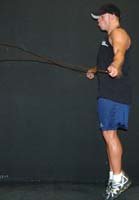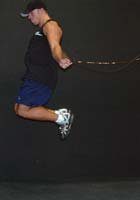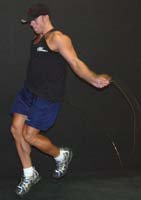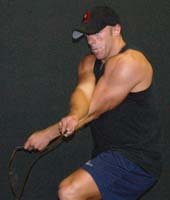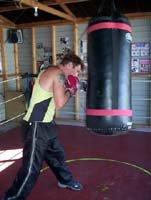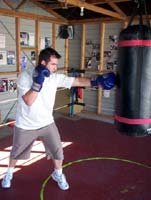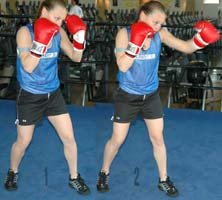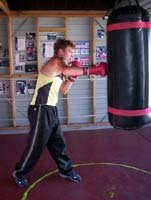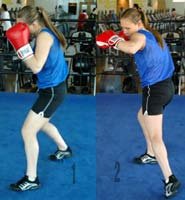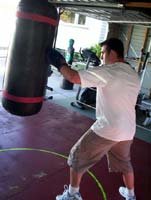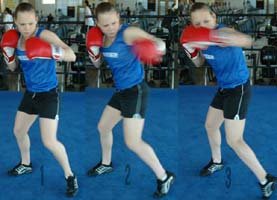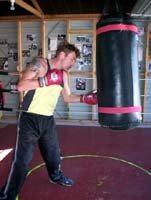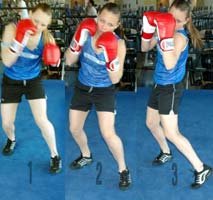The Question:
A boxing workout can increase endurance, strength and speed. Although boxing workouts can be cruel and intense, the risk is worth the reward.
Boxing workouts can consist of:
- Jumping rope
- Shadow boxing
- Heavy bag
- Speed bag
- Sparring
- Weight training
- Running
- Etc.
What is the best boxing workout? Be specific.
What are some of the benefits of following a boxing routine?
Do you think boxers should stay away from weight training, or is that just an old school myth?
Bonus Question: Have you ever followed a boxing workout? If so, how were the results?
Show off your knowledge to the world!
The Winners:
- 1. RC26
- 2. bigcalves
- 3. Live4this13
1st Place - RC26
Contact This Author Here. If you're looking to get into shape and back up your physique, then look further. In this article, I will reveal the best boxing workout that is guaranteed to whip you into fighting shape.Workout:
What is the best boxing workout? Be specific.
Boxing is approximately 80% anaerobic and 20% aerobic, which is why I included interval training along with cardio and weight training. This workout combines strength, power, speed, agility and quickness all into one to ensure you're a well-balanced fighter.
If you're not looking to become a boxer, you will need all of these things for self defense and it can help you become a better athlete in your sport.
Before getting into the actual workout, let me go over the activities and exercises you will utilize in your workouts.
Jumping Rope:
This popular form of cardio will reduce your body fat while providing a fun and intense workout. There are many other benefits of jumping rope that are vital for a boxer including improved coordination, quickness, endurance, agility, and footwork.
There are many types of different jump rope skipping styles, but here are the three you will need.
Running In Place:
Remain stationary spot while lifting the knees high with each turn of the rope. This is the basic and easiest style of jumping rope.
Double Unders:
Make two turns of the rope for every one jump. This style is more difficult to learn so use it only when you have mastered the running in place style.
Criss-Cross:
Cross the arms at the elbows on the descending swing of the rope and jump through the loop. Uncross the arms on the next descending swing and repeat the process. This style is great when looking for a challenging way of jumping rope.
Beginners looking to jump rope need to be patient, because it takes time to build your skills. If you tend to trip on the rope, don't become frustrated, just relax and try it again. Overtime, you will find it easy to jump rope and your skills will improve.
Shadow Boxing:
This is often performed as a warm-up before using the heavy bag. What you do is punch in the air using the reflection in the mirror as your opponent. Then perform some joint rotation exercises.
Heavy Bag:
The heavy bag has been around for a long time because it has helped boxers improve their overall skills without the need of a partner. This is also good for beginners, since it will get them ready for sparring.
The heavy bag has many benefits, and they are listed below.
Increase Aerobic Endurance:
Training with the heavy bag with maximum intensity increases your aerobic endurance. Divide the training into 3 five minute rounds where you look to throw as many punches as possible.
Increase Punching Power:
The heavy bag is the perfect tool for boxers to work on their punching power and technique. Beginners can learn to use the correct muscles when punching such as the shoulders, arms, chest, back, waist and legs. Keep in mind that the power first comes from the legs, then your waist which is your core shifts that power to your upper body.
Improve Coordination:
Throwing combinations and circling the bag will help your coordination. You will also improve your posture and your movements.
Improve Boxing Technique:
Try to perfect your stance and your punches when using the heavy bag. You will notice your techniques will greatly improve in a short period of time, and then you will be ready for sparring.
Improve Shape:
The heavy bag is an excellent form of cardio that will shred away excess body fat. Mix the heavy bag with jumping rope and you will be in tremendous shape.
Footwork:
Many individuals have trouble learning the correct stance and footwork, so here is a brief explanation of the popular orthodox stance.
- Stand with your feet about shoulder width apart
- Take a step forward with your left foot
- Your right foot should be kept at a 45 degree angle
- Shift your weight to the balls of your feet
- To keep proper balance, distribute your weight equally between your feet
- Keep your knees slightly bent
- Tuck your elbows to your sides
- Place your fists at cheekbone level
- Place your chin down and look up
- Roll your shoulders slightly forward
Punches:
Below is a list of some of the punches you can try on the heavy bag.
Jab - A rapid straight punch thrown with the lead hand. The movement begins with a slight turn of the hips and waist followed by a straight punch.
Cross - A straight punch thrown with the rear hand, while the lead hand is tucked against the jaw to protect the chin.
Hook - A half circled punch thrown with either hand targeted to hit the side of the opponent's head. Keep your rear hand tucked against your jaw to protect your chin.
Uppercut - A vertical punch thrown with the rear hand targeted to hit the opponent's chin. When performed correctly, an uppercut can ruin the opponent's balance.
Bolo Punch - An arm punch where its power comes from the reduction of a circular arc instead of the conversion of your body weight. This punch is rarely used in boxing.
Defense Techniques:
Here are some defense techniques you need to practice.
Slip - When the opponent throws a punch, rotate the hips and shoulders while turning the chin sideways to slip past the punch.
Parry - When the opponent throws a punch, quickly retaliate with a punch of your own to the opponent's wrist or forearm.
Bob & Weave - When the opponent throws a punch, move away from it by bending your legs and moving either right or left while bobbing your head under the punch.
Speed Bag:
One of the most effective ways to improve coordination and punching speed is by training with the speed bag. Beginners will have trouble utilizing the speed bag so keep practicing until you are able to get a steady rhythm for over 2 minutes. Once you are able to do that, divide your training into 3 five minute rounds.
Sparring:
Sparring with a partner is an integral part of your routine since it will showcase your progress. Try to throw jabs, hooks and even uppercuts. Just like heavy and speed bag training, divide it into 3 5-minute rounds.
Weight Training:
Training with weights will increase your strength and muscle size. Boxers need to focus on compound movements such as deadlifts and squats, which virtually work the entire body. Exercises such shoulder presses, pull-ups and crunches are also included in this program.
Exercises:
Barbell Deadlifts
This full body exercise mainly works the traps, quads, glutes, lower back and abs.
Barbell Squats
This exercise works the quads, hamstrings, glutes, lower back and abs.
Barbell Bench Press
This exercise works the pecs, along with the front deltoids and triceps.
Dumbbell Shoulder Presses
This exercise works the front and side deltoids.
Dumbbell Shrugs
This exercise works the traps intensely.
Reverse Barbell Curls
This exercise is excellent for strengthening the wrist, which is crucial for a boxer. It works the wrist extensors, brachioradialis, brachialis and biceps.
Pull-ups
This movement works the lats, with assistance from the biceps and brachioradialis.
Crunches
Works the upper abs.
Hanging Leg Raises
Works the lower abs.
Sets:
Keep your sets to 3 for compound and abdominal movements, and 2 for the rest of the exercises. Boxers train with weights to increase their strength and power, so there is no need to train with high volume.
Reps:
For compound exercises, your reps will be 5, and for the rest of the exercises, reps will be 8. However, when you perform crunches and hanging leg raises, perform 25 reps. Use correct form on all exercises to prevent injury.
Rest:
In between sets, you should rest between 1 and 2 minutes to ensure your muscles have recovered.
Running:
HIIT should be used when running since it will increase both aerobic and anaerobic endurance capacities, and it will burn calories faster than any other form of cardio.
Below is an explanation of how HIIT is performed.
Start with 5 minutes of warming up and stretching to get your body ready. Begin running at a regular pace for 1 minute, then increase the pace to 90 or 95% of your Maximum Heart Rate. Keep the pace going for 15 to 20 seconds, go back to the standard pace for 1 minute, and then repeat. Do this for 15 to 20 minutes and end it with a 5-minute cool down and stretch.
Stretching & Flexibility:
Include stretching in every workout day as it will prevent you from getting injured and increase your flexibility.
- Standing Toe Touches
- Seated Butterfly Stretch
- One Leg Over Stretch
- Neck Circles
- Shoulder Circles
- Arm Circles
- Elbow Circles
- Wrist Circles
- Knee Circles
- Ankle Circles
Equipment:
I recommend you buy the equipment listed below for your own safety.
- Handwraps- To protect the bones in the hands.
- Gloves- To protect the hands from getting injured.
- Mouthpiece- To protect your teeth.
- Headgear- To protect your head from getting cut and to prevent concussions.
- Cups- To protect the groin area.
Now onto the workout...
Beginners Boxing Workout:
The Split:
- Monday - Jumping Rope, Speed Bag, Sparring
- Tuesday - Weight Training
- Wednesday - Rest
- Thursday - Running
- Friday - Shadow Boxing, Heavy Bag, Sparring
- Saturday - Weight Training
- Sunday - Rest
Monday - Jumping Rope, Speed Bag, Sparring:
- Jump Rope for 3 three minute rounds.
- Hit the speed bag for 3 three minute rounds.
- Spar with a partner for 10 to 15 minutes.
Click Here For A Printable Log Of Monday.
Tuesday - Weight Training:
- Legs - Barbell Squat - 3 x 5, 90 second rest
- Lats - Pull-Ups - 2 x 8, 90 second rest
- Upper Abs - Crunches 3 x 25, 90 second rest
- Lower Abs - Hanging Leg Raises 3 x 25, 90 second rest
- Neck - Neck Bridge (Hold as long as possible) - 3 x 0, 90 second rest
Click Here For A Printable Log Of Tuesday.
Tuesday - Weight Training:
Thursday - Running:
Perform HIIT on a treadmill.
- Interval 1 - 1 minute regular pace, 15 second sprint at 90-95% MHR
- Interval 2 - 1 minute regular pace, 15 second sprint at 90-95% MHR
- Interval 3 - 1 minute regular pace, 15 second sprint at 90-95% MHR
- Interval 4 - 1 minute regular pace, 15 second sprint at 90-95% MHR
- Interval 5 - 1 minute regular pace, 20 second sprint at 90-95% MHR
- Interval 6 - 1 minute regular pace, 20 second sprint at 90-95% MHR
- Interval 7 - 1 minute regular pace, 20 second sprint at 90-95% MHR
- Interval 8 - 1 minute regular pace, 20 second sprint at 90-95% MHR
- Interval 9 - 1 minute regular pace, 15 second sprint at 90-95% MHR
- Interval 10 - 1 minute regular pace, 15 second sprint at 90-95% MHR
- Interval 11 - 1 minute regular pace, 15 second sprint at 90-95% MHR
- Interval 12 - 1 minute regular pace, 15 second sprint at 90-95% MHR
Click Here For A Printable Log Of Thursday.
Friday - Shadow Boxing, Heavy Bag:
- Shadow box for 5 minutes.
- Hit the heavy bag for 3 three minute rounds.
Click Here For A Printable Log Of Friday.
Saturday - Weight Training:
- Legs - Barbell Squat - 3 x 5, 90 second rest
- Lats - Pull-Ups - 2 x 8, 90 second rest
- Upper Abs - Crunches 3 x 25, 90 second rest
- Lower Abs - Hanging Leg Raises 3 x 25, 90 second rest
- Neck - Neck Bridge (Hold as long as possible) - 3 x 0, 90 second rest
Click Here For A Printable Log Of Saturday.
Sunday - Rest.
Advanced Boxing Workout:
The Split:
- Monday - Jumping Rope, Speed Bag, Sparring
- Tuesday - Weight Training, Running
- Wednesday - Shadow Boxing, Heavy Bag, Sparring
- Thursday - Jumping Rope, Speed Bag
- Friday - Weight Training, Running
- Saturday - Shadow Boxing, Heavy Bag, Sparring
- Sunday - Rest
Monday - Jumping Rope, Speed Bag, Sparring:
- Jump Rope for 3 five minute rounds.
- Hit the speed bag for 3 five minute rounds.
- Spar with a partner for 15 to 30 minutes.
Tuesday - Weight Training, Running:
- Legs - Barbell Squat - 3 x 5, 90 second rest
- Lats - Pull-Ups - 2 x 8, 90 second rest
- Upper Abs - Crunches 3 x 25, 90 second rest
- Lower Abs - Hanging Leg Raises 3 x 25, 90 second rest
- Neck - Neck Bridge (Hold as long as possible) - 3 x 0, 90 second rest
Perform HIIT on a treadmill.
- Interval 1 - 1 minute regular pace, 15 second sprint at 90-95% MHR
- Interval 2 - 1 minute regular pace, 15 second sprint at 90-95% MHR
- Interval 3 - 1 minute regular pace, 15 second sprint at 90-95% MHR
- Interval 4 - 1 minute regular pace, 20 second sprint at 90-95% MHR
- Interval 5 - 1 minute regular pace, 20 second sprint at 90-95% MHR
- Interval 6 - 1 minute regular pace, 20 second sprint at 90-95% MHR
- Interval 7 - 1 minute regular pace, 20 second sprint at 90-95% MHR
- Interval 8 - 1 minute regular pace, 20 second sprint at 90-95% MHR
- Interval 9 - 1 minute regular pace, 20 second sprint at 90-95% MHR
- Interval 10 - 1 minute regular pace, 15 second sprint at 90-95% MHR
- Interval 11 - 1 minute regular pace, 15 second sprint at 90-95% MHR
- Interval 12 - 1 minute regular pace, 15 second sprint at 90-95% MHR
Click Here For A Printable Log Of Tuesday.
Wednesday - Shadow Boxing, Heavy Bag, Sparring:
- Shadow box for 5 minutes.
- Hit the heavy bag for 3 five minute rounds.
- Spar with a partner for 15 to 30 minutes.
Click Here For A Printable Log Of Wednesday.
Thursday - Jumping Rope, Speed Bag:
- Jump Rope for 3 five minute rounds.
- Hit the speed bag for 3 five minute rounds.
Click Here For A Printable Log Of Thursday.
Friday - Weight Training, Running:
- Legs - Barbell Squat - 3 x 5, 90 second rest
- Lats - Pull-Ups - 2 x 8, 90 second rest
- Upper Abs - Crunches 3 x 25, 90 second rest
- Lower Abs - Hanging Leg Raises 3 x 25, 90 second rest
- Neck - Neck Bridge (Hold as long as possible) - 3 x 0, 90 second rest
Perform HIIT on a treadmill.
- Interval 1 - 1 minute regular pace, 15 second sprint at 90-95% MHR
- Interval 2 - 1 minute regular pace, 15 second sprint at 90-95% MHR
- Interval 3 - 1 minute regular pace, 15 second sprint at 90-95% MHR
- Interval 4 - 1 minute regular pace, 20 second sprint at 90-95% MHR
- Interval 5 - 1 minute regular pace, 20 second sprint at 90-95% MHR
- Interval 6 - 1 minute regular pace, 20 second sprint at 90-95% MHR
- Interval 7 - 1 minute regular pace, 20 second sprint at 90-95% MHR
- Interval 8 - 1 minute regular pace, 20 second sprint at 90-95% MHR
- Interval 9 - 1 minute regular pace, 20 second sprint at 90-95% MHR
- Interval 10 - 1 minute regular pace, 15 second sprint at 90-95% MHR
- Interval 11 - 1 minute regular pace, 15 second sprint at 90-95% MHR
- Interval 12 - 1 minute regular pace, 15 second sprint at 90-95% MHR
Click Here For A Printable Log Of Friday.
Saturday - Shadow Boxing, Heavy Bag, Sparring:
- Shadow box for 5 minutes.
- Hit the heavy bag for 3 five minute rounds.
- Spar with a partner for 15 to 30 minutes.
Click Here For A Printable Log Of Saturday.
Sunday - Rest.
Diet
If you want to be in the best possible shape and perform with maximum intensity, you need to get in the habit of eating the right foods and enough of them.
Eat every 2 or 3 hours to decrease hunger and sustain a high metabolism, which is necessary for fat loss. Eat plenty of protein, as much as 1.5 grams per pound of bodyweight, to ensure your body has all essential amino acids. Carbs should be kept between 2-and-4 grams per pound of bodyweight while fats should be kept low. Drink plenty of water throughout the day and supplement with a multivitamin/multimineral.
Rest:
Sleep at least 8 hours each day and don't train on your off days. Beginners have two off days since their bodies need to adapt to all the training.
Benefits:
What are some of the benefits of following a boxing routine?
There are several benefits of a boxing routine, so here is a list of them.
Increases in the following:
Decreases in the following:
- Fear
- Stress
- Body Fat Percentage
Improvement in the following:
- Fighting
- Discipline
- Confidence
- Body Shape
- Coordination
- Self Defense
Boxers & Weight Training:
Do you think boxers should stay away from weight training, or is that just an old school myth?
I think that is just an old school myth, because just like in most sports, athletes who have been taking advantage of weight training have done better in their sport. Boxing is no exception to that, since boxers need plenty of strength and power in order to deliver a knockout punch. Boxers also tend to have tremendous physiques which is an indicator of weight training use.
However, boxers in the lighter weight divisions should avoid putting on too much muscle mass, unless they want to become heavyweights. Putting on too much mass can also negatively affect speed, quickness and agility.
Bonus Question:
Have you ever followed a boxing workout? If so, how were the results?
I have followed a boxing routine in the past and I enjoyed being in fantastic shape. What amazed me the most though was the increase in my punching power and speed, along with great conditioning. Now I'm mainly focusing on bodybuilding, although I might follow a boxing workout very soon.
A boxing workout is perfect for the summer since it will shred away all excess body fat, helping you achieve a beach body look and reveal six pack abs.
I hope you have enjoyed this article and good luck with your boxing workout!
References:
2nd Place - bigcalves
Introduction
Boxing is a sport that requires great skill and athleticism and is fast paced. A typical boxer will need power, speed and endurance. Boxing is an explosive sport that requires multiple skill levels in order to be the best. It's not like any other sport out there.
You are not training for mass or bulk so you can be bigger than you opponent. Boxers have weight classes so hitting the weights to be huge is not an option. You need power and technical ability. It's not like weight lifting where you have to be at a certain strength level to compete.
I've seen smaller and weaker boxers that knocked out their opponent that was way stronger than them. This tells us that you need great technical skill in order to be successful. To sum it all up, we can see how a boxer must be multi-talented. Boxing is strategic and physical. The training of a boxer is not like anything else. You must sum all of these qualities and practice on them if you want to be the best.
Workout:
What is the best boxing workout? Be specific.
As mentioned in the introduction, boxing is a sport of many skills. You need to practice all of them in order to be the best. Here is a sample weekly workout that focuses on a boxers cardiovascular health, endurance, skills and technicality. This is only an example of what regular boxers do in order to achieve good results.
Monday:
- HIIT cardio 20 minutes (Consisting of springs and 20 seconds rest intervals)
- Shadow boxing for 20 minutes focusing on endurance
- Finish off with 20 minutes of jump roping
Click Here For A Printable Log Of Monday.
Tuesday:
Weight Training Day (See the weight training routine)
Wednesday:
- Running 3 miles
- Sparring 40 minutes (Focusing on technique rather than the cardio aspect)
- Finish off with speed bag for 15 minutes
Click Here For A Printable Log Of Wednesday.
Thursday:
Weight Training Day (See the weight training routine)
Friday:
- HIIT Cardio 20 minutes (Sprints with 20 second rest intervals)
- Speed Bag 15 minutes
- Heavy Bag 20 minutes
Click Here For A Printable Log Of Friday.
Saturday:
Weight Training Day (See the weigh training routine)
Sunday:
- Run 5 miles
- Sparring for 30 minutes
Click Here For A Printable Log Of Sunday.
Benefits:
What are some of the benefits of following a boxing routine?
For a boxer, the benefits are obviously being in better shape. Being technical and having high endurance while in the ring is something all boxers should strive for. Otherwise they will find themselves with someone who is levels above them and a knockout will be sure to follow.
As for amateur boxers or even those looking to stay fit and active a boxing routine is wonderful. It will give you power and endurance. Countless hours of running, weight training and sparring will help you keep your body healthy and fit while your muscles strengthen and develop higher capacity for endurance.
Let's not even mention the amazing cardiovascular effect you will get. Boxers are one of the top athletes with good heart health. All the activity required in a boxing routine will be sure to help your heart stay strong and active. A boxing routine is a great way to have a healthy and long life!
Boxers & Weight Training:
Do you think boxers should stay away from weight training, or is that just an old school myth?
Today's athletes are bigger and stronger than ever. If you look at the heavyweight champions from now, and compare them to champions in the 60s and 70s you will see a dramatic difference. The flab is gone and it's being replaced by rock hard muscle. This is not some new training routine or some new diet.
This is due to the fact that starting from the early 80s and greatly increasing, boxers have been weight training. All of the champs from our era have been hitting the weights hard and their physiques and performance can prove that.
In the olden days coaches advised athletes (including boxers) to stay away from weight training. The belief was that weights would make the athlete way too big and inflexible for their own good. Well, this is a big myth and today's athletes are living proof. Boxers who lift are simply bigger and stronger.
Weight lifting helps increase muscle mass to fat ratio. More muscle means more power and endurance. It is only wise for a boxer to weight train if they want to be the best. Forget the old school myth and focus on winning! Here is the weight training routine that will fit in with the rest of the boxing weekly workouts. This routine will be focused on getting more endurance, more muscle and power.
Tuesday:
- Squats: 4x 8, 8, 8, 6
- Leg Extensions: 3x 8, 8, 8
- Leg Curls: 3x 8, 8, 8
- Military Press: 4x 8, 8, 8, 6
- Side Raises: 4x 8, 8, 8, 8
- Front Raises: 4x 8, 8, 8, 8
- Shrugs: 3x 12, 12, 12
Thursday:
- Bench Press 3x 8, 8, 8
- Dumbbell Flyes 3x 8, 8, 8
- Cable Cross Overs 3x 8, 8, 8
- Triceps Pushdown 4 x 8, 8, 8, 8
- Dips: 4x till failure
Saturday:
- Wide-grip Pull Ups: 4x failure
- Lat Pulldown: 3x 8, 8, 8
- Cable Rows: 6x 8, 8, 6, 6, 4, 4
- Bicep Curls: 4x 8, 8, 6, 4
- Pullups: 3x till failure
* Mike Tyson has had weight training in his routine for sure.
Bonus Question:
Have you ever followed a boxing workout? If so, how were the results?
I have followed a boxing workout to improve my cardiovascular health. It helped a lot and it also prepared me for a season of wrestling. It gave me great muscular endurance and power. This routine is not for bodybuilders or those looking to gain mass. It is rather a routine to keep in shape and improve endurance, power and cardiovascular health: all important aspects when you are in the ring.
I suggest following this workout for a month or two and then testing your cardiovascular strength on the track. You will see amazing results on speed and how much better shape you are in. The results will simply amaze you.
Good Luck!


